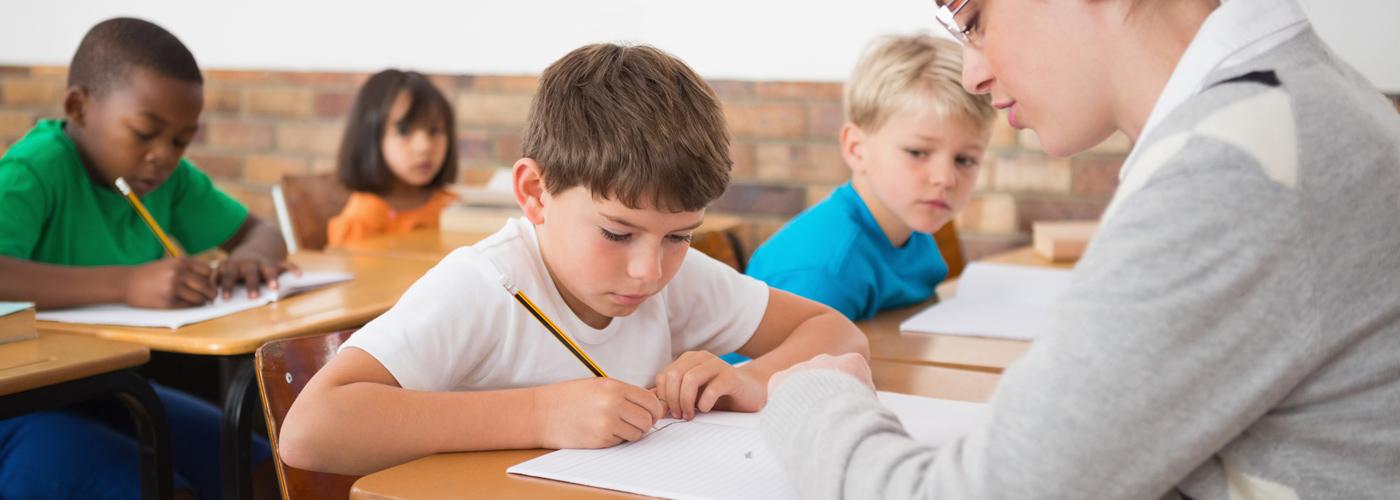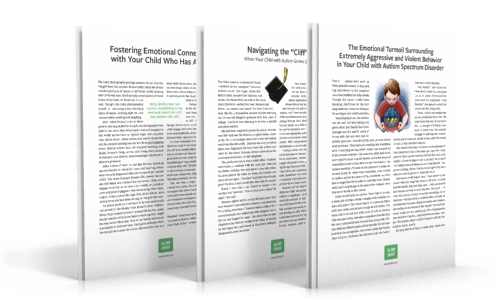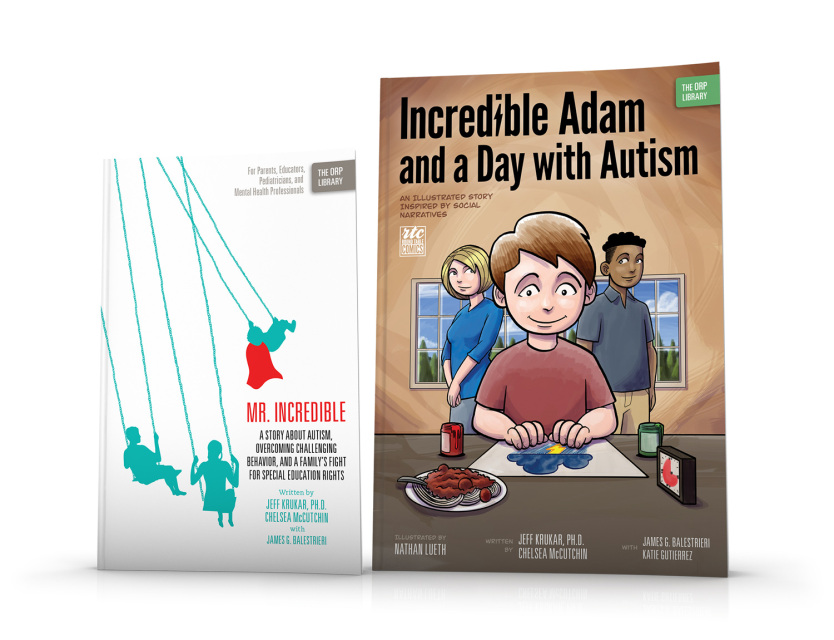Binders and Breakdowns: A Mother’s Introduction to the Individualized Education Plan Process
Written By: Julie Wallach
Resource Creation By: Bridget Morton
Design By: Christy Bui
“That’ll be $23.54, ma’am. Will that be debit or credit?”
“Debit, please,” I say, distracted. I’m watching my son as he rocks back and forth, covering his eyes with the palms of his hands. Fluorescent lighting in stores provides a lot of visual sensory input for my little guy. “Shane, we’re leaving in a just a minute. Mommy is almost finished.”
“Okay, Miss, just swipe your card, please.”
“Sure.” My head is turned away from the cashier as I swipe my card, keeping an eye on Shane to make sure he doesn’t get too overwhelmed.
“Ma’am? Your PIN, please.”
“Oh, yes. Sorry.” I enter my PIN, and the cashier hands me a plastic bag stuffed with a six-inch binder and all of its accessories: labels, tabs, plastic sheets. The bag is stretched to capacity, and I can’t help thinking it’ll probably rip by the time I get to the parking lot. Yes, I bought a lot of stuff, but it’s necessary to stay organized—and sane.
“I don’t need a receipt, thanks.” I grab my things and walk out of the store with Shane.
Outside, the sky is turning to dusk, which reminds me that it’s dinnertime. By the time we get home and I cook something halfway decent, it’ll be too late for Shane to eat. Why didn’t I crock-pot that chicken? “Do you want to get a burrito, Shane?”
“Yes. Best burrito in the world! Best burrito in the world,” Shane said, once again repeating his favorite TV ad. “Okay, let’s do it!”
We walk across the strip mall to a healthy Mexican fast food restaurant, Shane’s favorite, and order his favorite burrito. While we stand in line, he starts flapping his hands in front of his chest, and rocking. This place has fluorescent lights, too, which seems to make Shane rock faster, but we order our food for take-out and head out the door as soon as we can.
On the way back to the car, the plastic bag from the office supply store breaks, as I feared, and the contents drop to the ground. I check the binder to make sure it didn’t break and gather the labels and stickers that have scattered everywhere, all while holding Shane’s hand and balancing the bag of burritos on my arm. I brush off my frustration, even though my feet hurt, my head hurts, my stomach is growling, and my brain is ready for sleep. No time to complain or feel tired. I have a long night ahead.
“Best burrito in the world! Best burrito in the world!” Shane says, as we stand in the bathroom finishing the nighttime routine. When Shane was diagnosed with autism at three years old, the psychologist and occupational therapist recommended sticking to structure and routine as much as possible, and building in some sensory supports, to help him with predictability and regulation. For the most part since then, we’ve used the same routine for several years, and it’s been pretty successful.
“Yes, it was so yummy! It’s my favorite, too.”
"Yes, so good! So good!”
“Okay, brush your teeth now. Top and bottom, front and back, for one minute.”
“One minute.”
Pajamas are on, and it’s lights-out after we finish Shane’s favorite book, “Left Foot, Right Foot” by Dr. Seuss.
“Good night, Shane. I love you!”
“Shane, I love you,” he repeated.
He said I love you… but I don’t know if he meant it or was repeating.
I stand at the door and watch him move restlessly for a minute, then fade into sleep.
I love my little guy.

The binder has been waiting for me since we arrived home, ready to house the piles of paperwork about my son: a variety of evaluations, forms, and reports, including Shane’s Individualized Education Plan (IEP) information. Shane started school in late August, the referral was made in early September and now, in November, the school is hopefully getting to the first round of the process, which includes testing and observations in the classroom. I know there is a timeline, but it seems like it will take forever to get him the services he needs.
Because Shane has done so well with the behavioral supports I put in place years ago, for a while it seemed he didn’t need an IEP. But now that he’s in third grade, he’s really struggling academically. He’s just not learning the material like the other kids. I think it could be ADD, which can sometimes accompany autism. Then again, many kids with ASD also just have problems with attention. I don’t know. Autism can be so confusing. I do know that he needs extra time for tests, assistance organizing his work, and sometimes some one-on-one support really helps. The IEP will need to address these issues, as well as address keeping him on-task, as he can be distracted easily.
I sit down at my desk, leaving the TV on as background noise. For a moment I’m tempted to leave this mess of paperwork for another day and, instead of organizing and thinking, get in my pajamas and take the rest of the night to do nothing except eat ice cream and zone out with a mindless movie.
But this binder isn’t going to fill itself. Plus, I need it because all the paperwork, and what it means about my son and his future, stresses me out, and I can’t be stressed out; there’s no time for that, and Shane needs me to be strong for him.
I label the first tab “research” and add everything that I printed or copied when I started my quest to understand all things about autism spectrum disorder, IDEA, and IEPs. I read about things with terms like: “diagnostic features,” “differential diagnosis,” “comorbidity,” “response to Intervention,” and “present level of performance.”
As I punch holes in papers, I start to worry about Shane. Again. For the how many-eth time since he was diagnosed? How much time will all this take and will it help? And what will happen when it’s complete? Will it be implemented properly? Will he be in Mr. Williams’ or Mrs. Longroad’s class next year? Either way, they’re both good, although Mr. Williams seems a little bit more flexible, which Shane needs.
There’s so much to do. So much more to learn. And it’s already early November. Thanksgiving and then winter break will be here shortly. His IEP should be in place by then—let’s hope.
“Good morning, Lily!” I walk Shane into his classroom to get him settled, smiling at Shane’s third grade teacher, Lilian Ruiz.
“Well, hi there, Angie! How are you today, Shane?”
Shane looks outside at the trees blowing in the wind. “Here is what I learned. Today is Tuesday, October 28, 2014,” he says, never taking his eyes off the trees. “On October 28, 1962, the Cuban Missile Crisis ends. On October 22, 1962, President Kennedy tells Americans that missiles have been discovered in Cuba, which have the potential to attack the United States with nuclear warheads. On October 24, 1962, Strategic Air Command goes to DEFCON 2, for the only time in history. The Naval Blockade of Cuba by United States begins. On October 27, 1962, the U.S. informs its NATO allies that the United States may find it necessary within a very short time, in its interest and that of its fellow nations in the Western Hemisphere, to take whatever military action may be necessary, including invasion of Cuba. On October 28, 1962, Nikita Khrushchev informs the United States that he has ordered the dismantling of Soviet missile bases in Cuba. The U.S. informs the Soviet Union that they will not invade Cuba.” He has watched the trees during this whole speech.
“Thank you for that, Shane! I didn’t know about that. Certainly very interesting.”
Lily tries to make eye contact with Shane, whose eyes stay fixed outside. “How about if you take a seat and read your book? I’ll be right over—just going to have a quick chat with your mom.”
Shane walks to his seat, stopping to rock a bit, foot-to-foot, on his way there, then sits and opens his book.
“How are things going with the IEP team? Have you heard anything recently?” I ask.
Lily always gives me the latest updates on the process.
“It’s moving along. I heard the school has five IEP team referrals already this year, and Shane is one of them. They work hard. Yesterday, I had a talk with the school psychologist and it looks like they will be in contact about having the evaluation meeting sometime right after Thanksgiving.”
“I hope not too long after. What is Shane supposed to do until then? He’s having such a hard time staying focused right now and his grades, you told me, are just not good. I worry about him digging a real hole and his future….” I try to push down the anxiety rising in my voice; I don’t want to take this out on her.
“I know,” she says gently. “But meanwhile we’re going to do our best and make sure Shane gets the help he needs through regular education. You and I will keep doing what we’ve been doing: talking every morning before school to see how he’s doing so I can better understand how to present his instruction for the day. We will also continue to check in after school to talk about how his day went.”
“Thanks,” I say. “I don’t know what I’d do without you.”
“I really enjoy having your son in my classroom and working with parents like yourself,” Lily says.
Together we look over at Shane where he sits in his chair, gently rocking and reading his book.
“I just can’t stand knowing what I know—knowing what he needs and what he should be getting. I know you’re doing everything you can, and I so appreciate it. I just wish I had made the referral years earlier or listened to his teachers more….” Tears well up, and once again I feel the sense of helplessness and guilt that overcomes me far too often.
“I know. Really, I know,” Lily says. She looks me directly in the eye. “But you’re his hero. You know that, right? With a mom like you, he’ll be better than fine.”
I wipe my eyes, half laughing. “Believe me, I’m not always sure what I’m doing and I hope I’m doing the right things, but I’m going to keep at it for as long as it takes.”
“Of course, you love your son. Most importantly, Shane knows that. Now, go love yourself and get on with your day. We’ve got Shane now and it’s time for school.”
This story is part of a series based on the experiences of parents, educators and the staff of Genesee Lake School, a nationally recognized provider of services for students with special needs. GLS is part of MyPath, an employee-owned family of companies whose mission is to make a difference in the lives of people with disabilities.

Sign Up to Receive New Posts
We promise not to spam you or share your information with anyone. And you can unsubscribe at any time . . . although we hope you stay a while!






